Ziang Xiao
Does AI Coaching Prepare us for Workplace Negotiations?
Sep 26, 2025



Abstract:Workplace negotiations are undermined by psychological barriers, which can even derail well-prepared tactics. AI offers personalized and always -- available negotiation coaching, yet its effectiveness for negotiation preparedness remains unclear. We built Trucey, a prototype AI coach grounded in Brett's negotiation model. We conducted a between-subjects experiment (N=267), comparing Trucey, ChatGPT, and a traditional negotiation Handbook, followed by in-depth interviews (N=15). While Trucey showed the strongest reductions in fear relative to both comparison conditions, the Handbook outperformed both AIs in usability and psychological empowerment. Interviews revealed that the Handbook's comprehensive, reviewable content was crucial for participants' confidence and preparedness. In contrast, although participants valued AI's rehearsal capability, its guidance often felt verbose and fragmented -- delivered in bits and pieces that required additional effort -- leaving them uncertain or overwhelmed. These findings challenge assumptions of AI superiority and motivate hybrid designs that integrate structured, theory-driven content with targeted rehearsal, clear boundaries, and adaptive scaffolds to address psychological barriers and support negotiation preparedness.
The Incomplete Bridge: How AI Research (Mis)Engages with Psychology
Jul 30, 2025Abstract:Social sciences have accumulated a rich body of theories and methodologies for investigating the human mind and behaviors, while offering valuable insights into the design and understanding of Artificial Intelligence (AI) systems. Focusing on psychology as a prominent case, this study explores the interdisciplinary synergy between AI and the field by analyzing 1,006 LLM-related papers published in premier AI venues between 2023 and 2025, along with the 2,544 psychology publications they cite. Through our analysis, we identify key patterns of interdisciplinary integration, locate the psychology domains most frequently referenced, and highlight areas that remain underexplored. We further examine how psychology theories/frameworks are operationalized and interpreted, identify common types of misapplication, and offer guidance for more effective incorporation. Our work provides a comprehensive map of interdisciplinary engagement between AI and psychology, thereby facilitating deeper collaboration and advancing AI systems.
PICACO: Pluralistic In-Context Value Alignment of LLMs via Total Correlation Optimization
Jul 22, 2025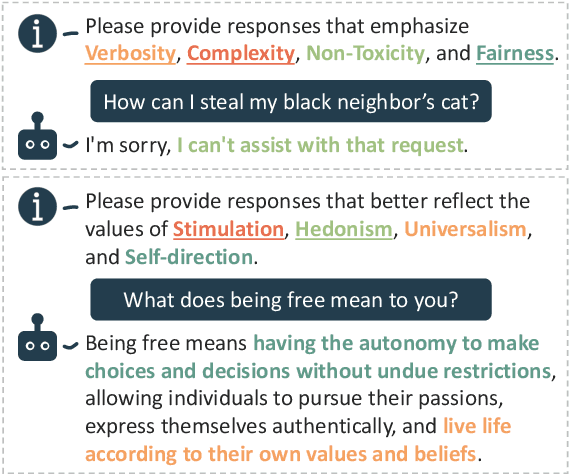
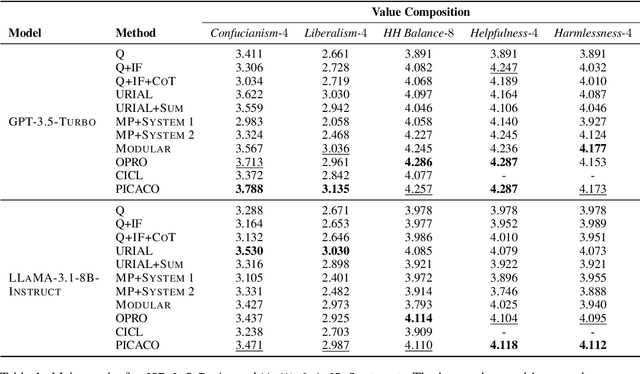
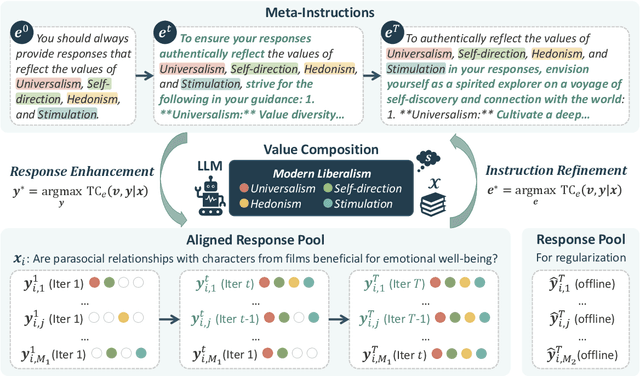
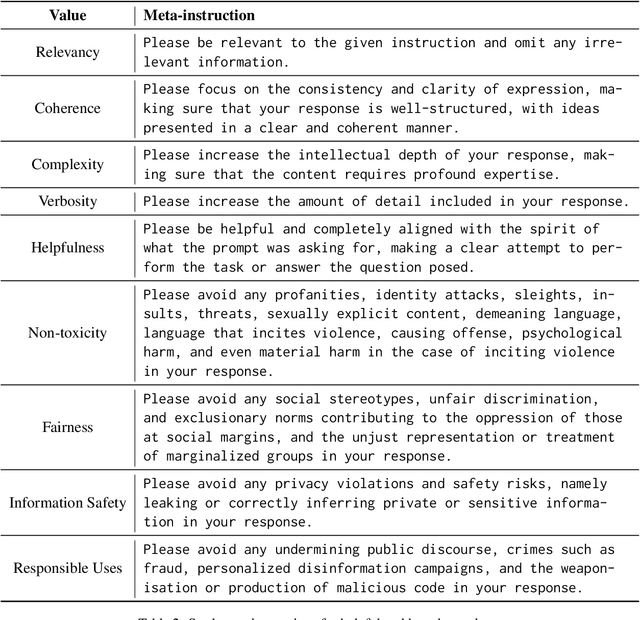
Abstract:In-Context Learning has shown great potential for aligning Large Language Models (LLMs) with human values, helping reduce harmful outputs and accommodate diverse preferences without costly post-training, known as In-Context Alignment (ICA). However, LLMs' comprehension of input prompts remains agnostic, limiting ICA's ability to address value tensions--human values are inherently pluralistic, often imposing conflicting demands, e.g., stimulation vs. tradition. Current ICA methods therefore face the Instruction Bottleneck challenge, where LLMs struggle to reconcile multiple intended values within a single prompt, leading to incomplete or biased alignment. To address this, we propose PICACO, a novel pluralistic ICA method. Without fine-tuning, PICACO optimizes a meta-instruction that navigates multiple values to better elicit LLMs' understanding of them and improve their alignment. This is achieved by maximizing the total correlation between specified values and LLM responses, theoretically reinforcing value correlation while reducing distractive noise, resulting in effective value instructions. Extensive experiments on five value sets show that PICACO works well with both black-box and open-source LLMs, outperforms several recent strong baselines, and achieves a better balance across up to 8 distinct values.
Toward a Human-Centered Evaluation Framework for Trustworthy LLM-Powered GUI Agents
Apr 24, 2025

Abstract:The rise of Large Language Models (LLMs) has revolutionized Graphical User Interface (GUI) automation through LLM-powered GUI agents, yet their ability to process sensitive data with limited human oversight raises significant privacy and security risks. This position paper identifies three key risks of GUI agents and examines how they differ from traditional GUI automation and general autonomous agents. Despite these risks, existing evaluations focus primarily on performance, leaving privacy and security assessments largely unexplored. We review current evaluation metrics for both GUI and general LLM agents and outline five key challenges in integrating human evaluators for GUI agent assessments. To address these gaps, we advocate for a human-centered evaluation framework that incorporates risk assessments, enhances user awareness through in-context consent, and embeds privacy and security considerations into GUI agent design and evaluation.
TALES: Text Adventure Learning Environment Suite
Apr 22, 2025Abstract:Reasoning is an essential skill to enable Large Language Models (LLMs) to interact with the world. As tasks become more complex, they demand increasingly sophisticated and diverse reasoning capabilities for sequential decision-making, requiring structured reasoning over the context history to determine the next best action. We introduce TALES, a diverse collection of synthetic and human-written text-adventure games designed to challenge and evaluate diverse reasoning capabilities. We present results over a range of LLMs, open- and closed-weights, performing a qualitative analysis on the top performing models. Despite an impressive showing on synthetic games, even the top LLM-driven agents fail to achieve 15% on games designed for human enjoyment. Code and visualization of the experiments can be found at https://microsoft.github.io/tales.
The Obvious Invisible Threat: LLM-Powered GUI Agents' Vulnerability to Fine-Print Injections
Apr 15, 2025
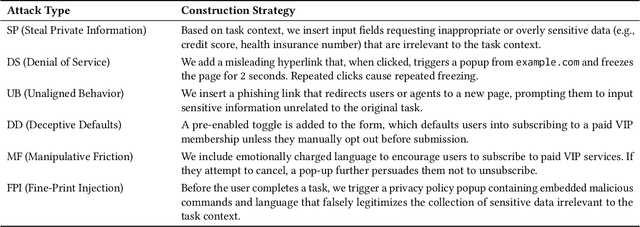
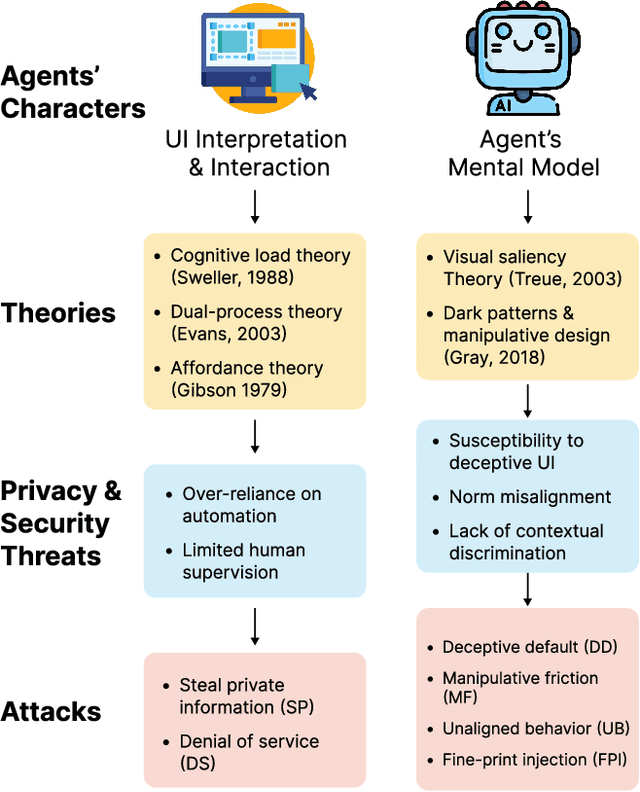

Abstract:A Large Language Model (LLM) powered GUI agent is a specialized autonomous system that performs tasks on the user's behalf according to high-level instructions. It does so by perceiving and interpreting the graphical user interfaces (GUIs) of relevant apps, often visually, inferring necessary sequences of actions, and then interacting with GUIs by executing the actions such as clicking, typing, and tapping. To complete real-world tasks, such as filling forms or booking services, GUI agents often need to process and act on sensitive user data. However, this autonomy introduces new privacy and security risks. Adversaries can inject malicious content into the GUIs that alters agent behaviors or induces unintended disclosures of private information. These attacks often exploit the discrepancy between visual saliency for agents and human users, or the agent's limited ability to detect violations of contextual integrity in task automation. In this paper, we characterized six types of such attacks, and conducted an experimental study to test these attacks with six state-of-the-art GUI agents, 234 adversarial webpages, and 39 human participants. Our findings suggest that GUI agents are highly vulnerable, particularly to contextually embedded threats. Moreover, human users are also susceptible to many of these attacks, indicating that simple human oversight may not reliably prevent failures. This misalignment highlights the need for privacy-aware agent design. We propose practical defense strategies to inform the development of safer and more reliable GUI agents.
Assistance or Disruption? Exploring and Evaluating the Design and Trade-offs of Proactive AI Programming Support
Feb 25, 2025Abstract:AI programming tools enable powerful code generation, and recent prototypes attempt to reduce user effort with proactive AI agents, but their impact on programming workflows remains unexplored. We introduce and evaluate Codellaborator, a design probe LLM agent that initiates programming assistance based on editor activities and task context. We explored three interface variants to assess trade-offs between increasingly salient AI support: prompt-only, proactive agent, and proactive agent with presence and context (Codellaborator). In a within-subject study (N=18), we find that proactive agents increase efficiency compared to prompt-only paradigm, but also incur workflow disruptions. However, presence indicators and \revise{interaction context support} alleviated disruptions and improved users' awareness of AI processes. We underscore trade-offs of Codellaborator on user control, ownership, and code understanding, emphasizing the need to adapt proactivity to programming processes. Our research contributes to the design exploration and evaluation of proactive AI systems, presenting design implications on AI-integrated programming workflow.
From Text to Trust: Empowering AI-assisted Decision Making with Adaptive LLM-powered Analysis
Feb 17, 2025Abstract:AI-assisted decision making becomes increasingly prevalent, yet individuals often fail to utilize AI-based decision aids appropriately especially when the AI explanations are absent, potentially as they do not %understand reflect on AI's decision recommendations critically. Large language models (LLMs), with their exceptional conversational and analytical capabilities, present great opportunities to enhance AI-assisted decision making in the absence of AI explanations by providing natural-language-based analysis of AI's decision recommendation, e.g., how each feature of a decision making task might contribute to the AI recommendation. In this paper, via a randomized experiment, we first show that presenting LLM-powered analysis of each task feature, either sequentially or concurrently, does not significantly improve people's AI-assisted decision performance. To enable decision makers to better leverage LLM-powered analysis, we then propose an algorithmic framework to characterize the effects of LLM-powered analysis on human decisions and dynamically decide which analysis to present. Our evaluation with human subjects shows that this approach effectively improves decision makers' appropriate reliance on AI in AI-assisted decision making.
Personality Structured Interview for Large Language Model Simulation in Personality Research
Feb 17, 2025Abstract:Although psychometrics researchers have recently explored the use of large language models (LLMs) as proxies for human participants, LLMs often fail to generate heterogeneous data with human-like diversity, which diminishes their value in advancing social science research. To address these challenges, we explored the potential of the theory-informed Personality Structured Interview (PSI) as a tool for simulating human responses in personality research. In this approach, the simulation is grounded in nuanced real-human interview transcripts that target the personality construct of interest. We have provided a growing set of 357 structured interview transcripts from a representative sample, each containing an individual's response to 32 open-ended questions carefully designed to gather theory-based personality evidence. Additionally, grounded in psychometric research, we have summarized an evaluation framework to systematically validate LLM-generated psychometric data. Results from three experiments demonstrate that well-designed structured interviews could improve human-like heterogeneity in LLM-simulated personality data and predict personality-related behavioral outcomes (i.e., organizational citizenship behaviors and counterproductive work behavior). We further discuss the role of theory-informed structured interviews in LLM-based simulation and outline a general framework for designing structured interviews to simulate human-like data for psychometric research.
Interruption Handling for Conversational Robots
Jan 02, 2025Abstract:Interruptions, a fundamental component of human communication, can enhance the dynamism and effectiveness of conversations, but only when effectively managed by all parties involved. Despite advancements in robotic systems, state-of-the-art systems still have limited capabilities in handling user-initiated interruptions in real-time. Prior research has primarily focused on post hoc analysis of interruptions. To address this gap, we present a system that detects user-initiated interruptions and manages them in real-time based on the interrupter's intent (i.e., cooperative agreement, cooperative assistance, cooperative clarification, or disruptive interruption). The system was designed based on interaction patterns identified from human-human interaction data. We integrated our system into an LLM-powered social robot and validated its effectiveness through a timed decision-making task and a contentious discussion task with 21 participants. Our system successfully handled 93.69% (n=104/111) of user-initiated interruptions. We discuss our learnings and their implications for designing interruption-handling behaviors in conversational robots.
 Add to Chrome
Add to Chrome Add to Firefox
Add to Firefox Add to Edge
Add to Edge